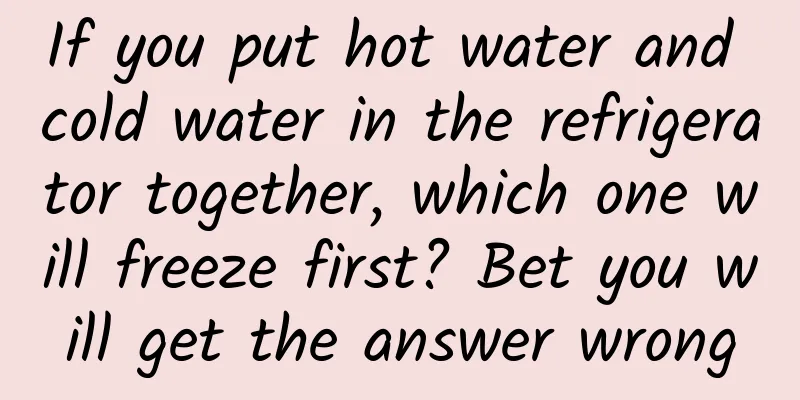If you put hot water and cold water in the refrigerator together, which one will freeze first? Bet you will get the answer wrong

|
A cup of hot water and a cup of cold water, they are exactly the same except for the temperature. Put the two cups of water in the refrigerator at the same time, which one will freeze first? Common sense tells us that the cold water should freeze first, but in 1963, Erasto Mpemba, a Tanzanian teenager who was still in middle school, discovered something different. At that time, he and his classmates were learning to make ice cream. They needed to add sugar to the hot milk first, wait for the milk to cool to room temperature, and then put it in the refrigerator to freeze it into ice cream. However, their refrigerator was a bit small, so in order to occupy the limited refrigerator space, he directly put the freshly boiled hot milk into the refrigerator. As a result, an hour and a half later, he found that his hot milk had been frozen into ice cream, but his classmates' room temperature milk was still in a thick milky state. Mpemba was very confused and asked his physics teacher, but was told that he must have made a mistake. Later, physicist Denis Osborne came to Mpemba's school to audit a physics course, and Mpemba asked him about this phenomenon. Osborne didn't believe it at first. The reason is simple. For example, if you put a cup of water with an initial temperature of 70℃ and another cup of water at 30℃ in the refrigerator at the same time, the 30℃ water will definitely freeze first. Because if the 70℃ water wants to freeze, it must first cool to 30℃, while the other cup of water is 30℃ at the beginning . The 70℃ water must spend more time cooling from 70℃ to 30℃ to freeze. Copyright images in the gallery. Reprinting and using them may lead to copyright disputes. But out of curiosity, Osborne also conducted experiments and was shocked to find that hot water sometimes freezes faster than cold water. Later, he invited Mpemba to the University of Dares Salaam in Tanzania to study this phenomenon together and named it the "Mpemba effect". In 1969, Mpemba and Osborne published this phenomenon in Physics Education. Over the past few decades, scientists have proposed many theories to explain the Mpemba effect. Some believe that hot water evaporates faster than cold water, and its volume is smaller than that of cold water, so it freezes faster; others believe that cold water has more dissolved gases, so its freezing point is lower; and some believe that external factors are at work: for example, the freezer of the refrigerator is likely to be covered with a layer of frost... Hot water will melt this layer of frost, thereby accelerating the heat transfer between the water and the refrigerator. Non-equilibrium thermodynamics However, all these explanations have a premise - the Mpemba effect is real, that is, hot water does freeze faster than cold water. But not everyone agrees with this premise. If you put a cup of hot water and a cup of cold water in the refrigerator to see which freezes into ice first, there is a high probability that the Mpemba effect will not be reproduced. In fact, even Mpemba and Osborne have never been able to stably repeat the initial experimental results. Henry Burridge, a physicist at Imperial College London, and Paul Linden, a mathematician at the University of Cambridge, tested the Mpemba effect in 2016. Unable to observe the freezing process directly, Burridge and Linden instead measured how long it took for water to cool from its initial temperature to 0°C. They were surprised to find that this result depended on where the thermometer was placed in the water: if the thermometer was placed at the same depth, the Mpemba effect would not occur between cold and hot water; but if the depth of the thermometer deviated by even 1 cm, the Mpemba effect might be falsely "confirmed." The results of the experiment by Burridge and Linden show the high sensitivity of the experiment. Although it cannot be used to determine whether the Mpemba effect exists, it reveals the key reason why this effect is so unstable: when a glass of water is cooled rapidly, it is actually in an unstable non-equilibrium state. Copyright images in the gallery. Reprinting and using them may lead to copyright disputes. For a glass of water at a constant temperature, each molecule may have different speeds, but their overall kinetic energy always follows a specific energy distribution, that is, equilibrium. We often use temperature to measure different equilibrium states. The hotter the system, the more molecules in it are in a faster state. But if the temperature of a system is changing rapidly, then it may no longer be in equilibrium, but become an unstable non-equilibrium system. For example, when hot water is rapidly cooled in a refrigerator, it is in a non-equilibrium state, and it will eventually become a block of ice in thermodynamic equilibrium. There is a special physics term to describe this process: relaxation , which refers to the process of a non-equilibrium system returning to equilibrium (not necessarily cooling, but also rapid heating). The term "Relaxation" is very interesting. It not only refers to the physical system returning to equilibrium, but it seems to be telling physicists to relax and return to the familiar equilibrium state - because even now, we know very little about non-equilibrium thermodynamics. In non-equilibrium systems, the thermodynamic laws we are accustomed to no longer apply, because they are all laws summarized from systems in thermodynamic equilibrium. In non-equilibrium states, the concept of temperature no longer even exists, because temperature is just a parameter abstracted by physicists to facilitate the description of the overall state of particles in equilibrium. For non-equilibrium systems, the temperature we understand does not exist at all - we will be directly faced with a large number of disordered, fast-moving, and rapidly changing particles, and we need completely new theories, equations, and research methods. Fortunately, this discipline has been developing rapidly in recent years, and we are gradually approaching the truth of the Mpemba effect. Virtual reality simulation In 2017, Zhiyue Lu, an assistant professor in the Department of Chemistry at the University of North Carolina, and others published a paper in the Proceedings of the National Academy of Sciences (PNAS). Through random particle dynamics simulations, they found that under certain conditions, both the Mpemba effect and the reverse Mpemba effect (such as cold water heating up faster than hot water) may occur. The results show that particles in hotter systems have more energy and can therefore try more paths of temperature change, including a "shortcut": during the cooling process, the hot system can surpass the cold system through the shortcut and reach the final state faster. The paper theoretically proved that the Mpemba effect can be realized, and in 2020, a paper published in Nature stably reproduced the Mpemba effect with real and accurate experiments. The authors used a laser to create a W-shaped one-dimensional potential well on the water surface. The glass beads used in the experiment can get rid of the influence of gravity on the water surface and move in the manner prescribed by the potential well. The deeper valley in the W shape represents the final stable equilibrium state of the system; while the other shallower valley represents a metastable state of the system closer to the final equilibrium state, because the particle may fall into it, but it is more likely to fall into the deeper valley in the end. Image credit: Merrill Sherman/Quanta Magazine The researchers placed the glass bead at different locations in the one-dimensional potential well, repeated the experiment a thousand times, and then superimposed the results of the thousand observations. In this way, a system of a thousand individual particles is equivalent to a system containing a thousand particles. The researchers placed glass beads anywhere in the potential well to simulate an initially hotter system. Because hot systems contain more energy, particles can more actively roam around and explore the energy landscape. When simulating colder systems, it is necessary to limit the initial position of the glass beads to an area close to the deep valley. When simulating the cooling process, the glass beads will first sink into one of the valleys, and then, under the perturbation of water molecules, the glass beads will jump back and forth between the two valleys. When the ratio of the length of time the glass beads stay in each valley is stable, it can be determined that it has completed the cooling process. Depending on the water temperature of the environment in which the glass beads are located and the size of the potential well, the criteria for determining whether the cooling is complete are also different. For example, the particle can be judged to have completed cooling by falling into a metastable state 20% of the time and falling into a stable state 80% of the time. Under certain initial conditions, it makes sense that a hot system would cool more slowly than a cold system, which is in line with our intuition. But sometimes, the particles in the hot system sank into the valley faster. When the experimental parameters were tuned just right, the particles in the hot system reached the prescribed cooling state almost instantly, much faster than the particles in the cold system—a phenomenon that researchers had long predicted and named the Jhampemba effect. Universal proof Since both theoretical simulations and real experiments have reproduced the Mpemba effect, for most people, this problem has been solved. However, these two experiments only prove that the Mpemba effect does exist through specific computer simulations or specific experimental designs. Even in theory, in certain experimental settings, the relaxation time corresponding to the Mpemba effect can only occur after an "infinitely long" time. For those physicists who are a bit "mentally clean" and prefer theory, they also hope to prove the Mpemba effect universally based on the existing non-equilibrium thermodynamics theory . In March this year, a paper published in Physical Review Letters gave a rigorous proof of the Mpemba effect. The proof of the paper used a mathematical theory of majorization. Mathematically, majorization refers to two vectors A and B of the same dimension. If the values of different components are arranged in descending (or ascending) order, and the components of the two vectors are compared in order, if the components of vector A are always greater than those of B, then vector A is said to be superior to vector B. For example, vector (1, 5) is superior to (0, 4) because 1>0 and 5>4. And vector (1, 5) is also superior to (4, 0) because the vectors themselves need to be sorted before majorization comparison. Using majorization, mathematicians, scientists, and engineers can develop many optimization algorithms. The most famous one is the Majorization-Minimization algorithm. The EM algorithm, which is commonly used in machine learning, is actually the application of the MM algorithm in statistical models. The MM algorithm also has many applications in quantum computing. In this paper, the researchers introduced the thermomajorization theory. In short, the traditional thermomajorization theory compares two vectors, while the thermomajorization theory compares the degree of deviation of different vectors (high-dimensional vectors can be used to represent the state of non-equilibrium systems) from the thermal equilibrium state. Through the theory of thermal superiority, the research team derived the universal conditions for the Mpemba effect to occur in a finite time under all monotonic potentials. Specifically, for two systems, warm and hot, if both are cooled to a certain temperature, the Mpemba effect will occur when the Gibbs distribution of the warm system thermally superiors the Gibbs distribution of the hot system. With the rapid development of non-equilibrium thermodynamics, we can finally prove the Mpemba effect in theory. Hot water can indeed freeze faster than cold water under certain circumstances. References [1]https://iopscience.iop.org/article/10.1088/0031-9120/4/3/312 [2]https://www.pnas.org/doi/abs/10.1073/pnas.2118484119 [3]https://www.nature.com/articles/s41586-020-2560-x [4]https://journals.aps.org/prl/abstract/10.1103/PhysRevLett.134.107101 [5]https://mp.weixin.qq.com/s/lN30cNJjhRbvC8Uzr69VvQ [6]https://mp.weixin.qq.com/s/BoGfkfl4xRFzo0WEk38IuQ [7]https://www.quantamagazine.org/does-hot-water-freeze-faster-than-cold-physicists-keep-asking-20220629/ [8]https://palomar.home.ece.ust.hk/papers/2011/WangPalomar_CRCPress2011_majorization.pdf Planning and production Source: Global Science (ID: huanqiukexue) Author: Wang Yu Review丨Sun Mingxuan, Professor of Shanghai University of Engineering Science Editor: Yinuo Proofread by Xu Lai and Lin Lin The cover image and the images in this article are from the copyright library Reprinting may lead to copyright disputes |
>>: The "overlord" soaring into the sky: How did dinosaurs "regain life" in the blue sky?
Recommend
You must pay attention to these issues when upgrading to Windows 10
Microsoft's Windows 10 operating system will ...
Please don’t step on the grass! Is it okay to step on the grass?
Produced by: Science Popularization China Author:...
Edge browser expands translation capabilities on Android platform
Following the screenshot feature, Microsoft conti...
Dyeing the lake pink! It’s for science…丨Environmental Trumpet
Hello everyone, this is the 18th issue of the Env...
Huawei files lawsuit against FCC, alleging it violates U.S. Constitution
[[284776]] On December 5, Huawei's Shenzhen h...
Weekly Technology Award|The beginning of the dream of a lively metal battery
Electricity supports our daily lives: we use batt...
It's like a long-distance relationship
More than two thousand years ago, Mozi wrote in &...
Famous Ships in Chinese History (VIII)
Today I would like to introduce to you the first ...
12306 electronic temporary identity card is now available! Official explanation: Apply in five simple steps
According to @中国铁路官方微信, starting today (January 1...
Black holes also come in pairs? The heaviest supermassive black hole pair ever discovered!
Using archival data from the Gemini North telesco...
Lenovo + Motorola + Xiaomi > Apple + Samsung
Remember this past Thursday, remember October 30t...
Community operation: the key point to keep the community active!
I ate and drank too much in the first half of the...
Advancing towards the center of the earth: Is it necessary to go deep into the ground ten thousand meters deep?
Produced by: Science Popularization China Author:...
How to create a popular WeChat mini-program mall?
Nowadays, many brands have become popular with th...
How does APP operation guide users?
User Onboarding, which means user guidance. Simpl...









